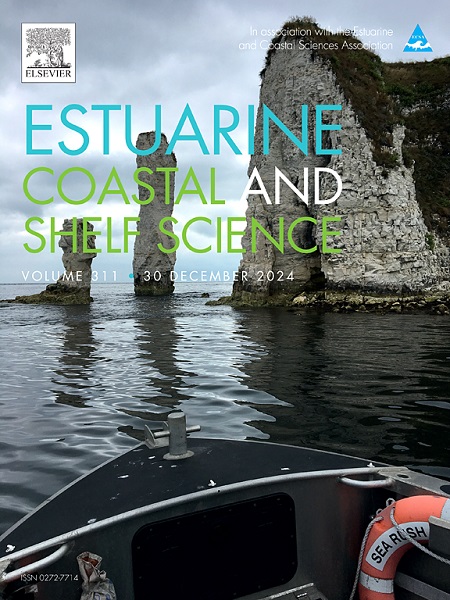Exploring the land-ocean biogeochemical and microbial connectivity in the Ría de Vigo (NW Iberian Peninsula) through submarine groundwater discharge
IF 2.6
3区 地球科学
Q1 MARINE & FRESHWATER BIOLOGY
引用次数: 0
Abstract
Increasing evidence demonstrates the widespread occurrence of submarine groundwater discharge (SGD) in coastal zones, where it may influence biogeochemistry and microbial ecology. Here, we analyze the biogeochemical composition and microbial communities across diverse aquatic environments in a highly productive coastal system (Ría de Vigo, NW Iberian Peninsula), influenced by significant fresh SGD, to assess the extent of microbial and biogeochemical connectivity—i.e., mass transfer—among them. Samples were collected from surface and deep porewaters from two subterranean estuaries (STEs), surface seawater, riverine water, and continental groundwater. These samples were analyzed for a comprehensive set of microbial and biogeochemical variables, including radioisotopes used as SGD tracers. A significant correlation between SGD tracers and carbonate system parameters, N2O, and CH4 concentrations in surface seawater indicates SGD influences biogeochemistry of the embayment. However, some of these solutes do not originate from continental groundwater but are produced in the local STEs, which act as biogeochemical reactors modifying fresh SGD. The findings also reveal highly diverse microbial communities, with higher diversity in STEs due to the variety of niches present. Indicator taxa included the phyla Euryarchaeota, Chloroflexi, Omnitrophicaeota, and the family Nitrosopumilaceae in STEs; the phylum Cyanobacteria and the family Burkholderiaceae in freshwater endmembers; and the Flavobacteriaceae and Cryomorphaceae families in seawater. Most operational taxonomic units (∼87 %) were unique to a single environment (river, continental groundwater, coastal water, or STE), showing STEs limit subterranean microbial transfer between groundwater and marine ecosystems. Our results highlight STEs as reservoirs of diversity and zones of intense biogeochemical reactivity.

通过海底地下水排放探索Ría de Vigo (NW伊比利亚半岛)陆海生物地球化学和微生物连通性
越来越多的证据表明,海底地下水排放(SGD)在沿海地区广泛发生,可能影响生物地球化学和微生物生态学。在这里,我们分析了受显著新鲜SGD影响的高产海岸系统(Ría de Vigo, NW Iberian Peninsula)中不同水生环境的生物地球化学组成和微生物群落,以评估微生物和生物地球化学连通性的程度。比如,质量传递。样品采集自两个地下河口(STEs)的表层和深层孔隙水、表层海水、河流水和大陆地下水。对这些样品进行了全面的微生物和生物地球化学变量分析,包括用作SGD示踪剂的放射性同位素。SGD示踪剂与表层海水中碳酸盐体系参数、N2O和CH4浓度显著相关,表明SGD影响了海湾的生物地球化学。然而,这些溶质中的一些并非来自大陆地下水,而是在当地的STEs中产生的,这些STEs作为生物地球化学反应器修饰新鲜的SGD。研究结果还揭示了高度多样化的微生物群落,由于生态位的多样性,STEs的多样性更高。指示分类群主要有古菌门、绿藻门、全硝化菌门和亚硝化菌科;淡水末端的蓝藻门和伯克霍尔德菌科;海水中的黄杆菌科和冷胚科。大多数可操作的分类单位(约87%)是单一环境(河流、大陆地下水、沿海水或STE)所特有的,表明STE限制了地下水和海洋生态系统之间的地下微生物转移。我们的研究结果强调了ste是具有多样性的储层和强烈的生物地球化学反应带。
本文章由计算机程序翻译,如有差异,请以英文原文为准。
求助全文
约1分钟内获得全文
求助全文
来源期刊
CiteScore
5.60
自引率
7.10%
发文量
374
审稿时长
9 months
期刊介绍:
Estuarine, Coastal and Shelf Science is an international multidisciplinary journal devoted to the analysis of saline water phenomena ranging from the outer edge of the continental shelf to the upper limits of the tidal zone. The journal provides a unique forum, unifying the multidisciplinary approaches to the study of the oceanography of estuaries, coastal zones, and continental shelf seas. It features original research papers, review papers and short communications treating such disciplines as zoology, botany, geology, sedimentology, physical oceanography.

 求助内容:
求助内容: 应助结果提醒方式:
应助结果提醒方式:


